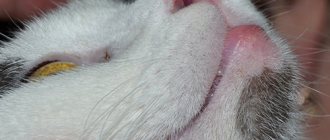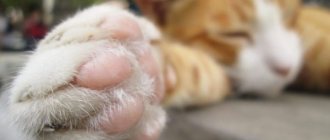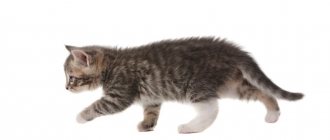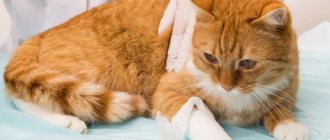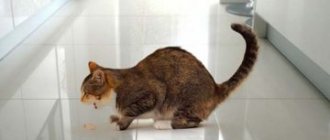Cats are very graceful and flexible animals. Their ability to deftly overcome even very high obstacles is admirable. But sometimes the owner may notice that the cat has a limp and a swollen paw, and there is no trace of grace left. This is a reason to carefully assess your pet’s health status and, if necessary, consult a doctor.
The cat's paw is swollen: the main reasons
Edema is an excess accumulation of fluid in tissues. It develops as a result of an inflammatory process when the amount of incoming fluid exceeds the volume of outflow. The affected surface increases in size. Most often, swelling is noticeable on the paws, because in such cases the behavior changes: the cat holds the limb suspended or limps.
Swellings on the paws develop for the following reasons:
- injuries - wounds, dislocations, sprains, fractures;
- allergy;
- arthritis - inflammatory diseases of the joints;
- chronic diseases of the kidneys, liver, heart;
- lymphadenitis;
- malignant tumor.
The cat owner can try to make a preliminary diagnosis on his own. You should pay attention to which limbs are affected, rear or front? Swelling is expressed on both paws or just one. The cat holds his paw up, or leans on it, but limps.
Is there a noticeable cut on the paw, is there bleeding? Are additional pathological symptoms detected? If the cause is established, first aid is provided and sent to the clinic. If the cause of the swelling is unknown, seek veterinary help without providing first aid.
Diagnostic methods
Regardless of the cause of the edema, it is always necessary to carry out diagnostics, which are done in an inpatient setting. This should be done by a doctor, after an examination he will be able to make an accurate diagnosis. Diagnostics helps to find out what caused the swelling, especially if it is impossible to identify visible damage and recognize the causes of the symptoms. Primary diagnosis includes a standard external examination of the limb and the animal as a whole.
The cat is limping on its front leg without visible damage
Important! It is necessary to carry out a diagnosis in any case; you should not treat your pet at home on your own without a veterinarian. This is fraught with negative consequences and deterioration of the animal’s condition.
X-ray of paws
After an external examination, blood and other body fluids are tested and, if necessary, a cardiogram is performed to evaluate the functioning of the heart. To assess damage to a limb, your doctor will perform an MRI or X-ray to check for fractures, dislocations, and bruises. If the diagnosis is confirmed, the swollen limb is treated and treatment is prescribed.
First aid if a cat has a swollen paw
The actions of a cat owner vary depending on the main symptom. What is the nature of the damage? Is your pet holding his paw up and unable to step on it, or is he just limping?
Be sure to read:
Interpretation of blood tests in cats: features of the procedure, types, main indicators, norms
The cat's paw is swollen and cannot step on: what to do?
The cause of the pathology is a cut or puncture wound caused by sharp objects or a bent claw that has grown into the pad of the finger. Alternatively, a splinter.
In such cases, cut off the claw or remove the foreign object embedded in the paw, and treat the wound with an antiseptic spray. Observe the pet’s behavior, palpate the paw to identify pain, as well as local hyperthermia. If the condition does not improve within a day, call the veterinarian.
The cat has a swollen paw and is limping: what to do?
In this case, it is necessary to exclude a traumatic cause of the disease, and also take into account the age of the pet. If both hind legs swell and your cat is not in pain, he most likely has a chronic disease. Older pets get sick more often than younger ones because they are susceptible to heart, kidney or liver failure.
In this situation, the owner is unable to help, so it is necessary to entrust the treatment to a professional.
Edema and edema are different
Swelling of cat limbs is many-sided and varied, as are the causes that cause them. A cat's paws may swell:
- in a separate relatively small area - with the so-called localized (local or limited, otherwise local) edema;
- over a large area or over the entire surface of the limb - with generalized (or general) edema.
Often the swelling occurs on one paw of the animal (asymmetrical/asymmetrical edema), less often - on two at once (symmetrical edema).
Photo gallery: types of paw edema in cats
Localized swelling occurs in a relatively small, localized area of the cat's paw
Generalized edema covers a significant area of the animal's limb
Symmetrical swelling appears on both legs of the pet at once
Moreover, in most cases, just by the appearance and location of the swollen areas, one can assume what caused their appearance. Moreover, swelling of the paws characteristically affects the behavior of the animal and is often accompanied by additional specific symptoms.
How to treat if a cat has a swollen paw
If a cat has mechanical damage as a result of a cut, bite, embedded splinter, dislocation or fracture, it is necessary to fix the paw and apply cold. Subsequent actions must be entrusted to a specialist. The veterinarian will determine the cause of the pathology visually or using instrumental studies (X-rays, etc.).
The specialist will straighten the dislocation, apply stitches, bandage it, and prescribe antibiotics. Further actions of the owner are aimed at fulfilling the doctor’s orders.
In some cases, an allergic reaction develops to an insect bite. Only one paw is affected, mainly the front one, swelling develops at the site of the bite, and the local temperature rises. If the pathological symptom does not go away within a few hours, veterinary attention will be required. The veterinarian will administer an antihistamine and the swelling will subside.
Arthritis develops mainly in older pets. The reason is a metabolic disorder due to an unbalanced diet. Obesity and chronic diseases develop. One or both hip joints are swollen, painful, hot, and the skin is tense.
The main task of the veterinarian is to reduce pain.
The treatment is long-term, complex, and develops in the following areas:
- drug therapy using anti-inflammatory drugs and antibiotics;
- therapeutic diet using ready-made food for cats with joint diseases;
- physiotherapy.
Be sure to read:
What to do if your cat’s ears are red, itchy or spots appear: causes of the disease
One of the pathological symptoms of heart, liver, and kidney failure is symmetrical swelling of the paws. They suffer. mainly older pets. The disease is incurable. Symptomatic treatment allows you to maintain your pet’s well-being at a satisfactory level.
Lymphadenitis is inflammation of the lymph nodes. Develops as a complication of an infectious disease. The lymph nodes are enlarged and can be detected by palpation. The swelling extends only to the front legs and is accompanied by lameness. If the underlying disease is treated, the lymph nodes will shrink and the swelling will subside.
Most often, cancer affects the mammary glands of an older cat. The swelling extends to the hind legs. Animals whose owners abuse hormonal contraceptives become ill. Treatment is symptomatic, supportive, the prognosis is unfavorable.
Calm, only calm: we observe and inspect
The first thing to do if your furry dog has a swollen paw is to observe his behavior. Don't panic and remember: in the process of monitoring your pet, you should get all the useful information possible. It is important for you to understand:
- whether the animal is in pain;
- is he afraid to lean on his swollen paw?
- Is your pet limping?
- has the cat become less mobile?
- whether he experiences atypical stiffness in movements;
- Is the animal bothered by itching?
At the next stage, you need to carefully and carefully examine the sore paw, and then the entire pet. This will reveal additional symptoms:
- the presence of open wounds and suppuration in the area of edema;
- changes in skin color in swollen areas (redness, paleness, or blueness);
- local temperature change;
- the appearance of peeling, dandruff, unpleasant odor;
- increased salivation and watery eyes of the animal;
- soreness in areas adjacent to the swollen body.
Peeling skin on a swollen area of a cat's paw is an additional symptom that should not be ignored.
It is important to remember that when conducting such an examination there are no trifles: if you contact a specialist, any deviation from the norm you notice (even the most insignificant) can help in making the correct diagnosis.
Your further actions will directly depend on the results obtained from observing and examining the cat.
Why is it important to find “your” doctor?
Unfortunately, sometimes the cause of swelling of a cat's paw can be a completely ordinary visit to the veterinarian. The first time I encountered such a situation was when my friend was preparing her Sphynx to move to a distant country. By all indications, the cat was absolutely healthy, but the rules required some kind of special blood test. At the veterinary clinic, blood from the vein was taken for analysis without any problems and a pressure bandage was applied to the injured paw to prevent the formation of a hematoma. Everything was done according to the rules, but they forgot to warn the owner that the bandage needed to be removed in about an hour. And my conscientious friend, deciding that it was better to be safe than sorry, left her paw wrapped until the morning (it was in the evening). And early in the morning it turned out that the long-suffering cat’s limb was twice as thick as it was the day before. Fortunately, nothing irreparable happened: it did not lead to tissue necrosis, the paw remained warm and retained sensitivity. So periodic massage and a loose bandage of alcohol-soaked gauze (recommended by another veterinarian) reduced the swelling by lunchtime. The second case directly affected my pet: during the drip administration of vitamins, a poorly secured catheter moved, and the drug went under the skin (instead of a vein). The paw was swollen, any touch to it caused pain, the baby refused to eat. A repeat visit to the veterinarian and a tight bandage with magnesium sulfate applied for an hour and a half corrected the situation. And this time, fortunately, there were also no serious consequences (in the form of an abscess, for example). As it turns out, such cases happen periodically. What can you do: cats are far from the calmest and most obedient patients. However, whatever you say, the doctor’s qualifications also play an important role. Therefore, do not be lazy to make inquiries and find a truly good specialist for your pet (if you value his health, of course). Believe me: a visit to the veterinary clinic closest to your home is not always the right step.
Drug treatment of tumors
Veterinarians practice drug treatment of tumors in the following cases:
- Abscesses. They are opened (i.e., surgery is still necessary), the cavity is washed with 3% hydrogen peroxide, and filled with streptocide or other antiseptic powder. Sometimes drainage installation is required. In most cases, antibiotics are prescribed.
- Some types of arthritis, arthrosis. Chondroprotectors are prescribed (Hip and Joint Extra Nutri-Vet, Dolfos ArthroFos, Chondroitin complex and others), as well as anti-inflammatory corticosteroids.
- Fungal pathologies. Antifungal drugs are used (Itraconazole, antibiotics from the griseofulvin group, Yam ointment and others).
Surgical removal of the tumor
In more severe cases, surgical removal of the tumor is used:
- Serious arthritis and arthrosis. Dead tissue is excised and, in ideal cases, joint replacement implants are installed.
- Malignant and benign tumors. They are cut out, trying (especially in the case of cancer) to capture as much adjacent tissue as possible. In addition, chemotherapy drugs are prescribed for cancer.
- Hematomas. They are opened, the cavity is washed with hydrogen peroxide and filled with antiseptic powder.
What to do before visiting a doctor?
Once swelling is detected, the limb must be examined. The presence of a wound or damage will make the task easier. This immediately indicates the cause of the swelling. In this situation, you can cope on your own if there is no suppuration. Stages of assistance:
- wash the wound with an antiseptic (Chlorhexidine, hydrogen peroxide solution);
- treat the area around the injury with iodine, and in case of severe swelling - with alcohol;
- apply a bandage soaked in Ichthyol and Levomekol.
It is recommended to change the bandage once a day; when removed, the wound is washed again with an antiseptic. If there is no improvement or the situation worsens, then only a veterinarian can help. It is necessary to go to the clinic even if there are no injuries, since the cause of the pathology in this situation can only be determined by a professional. Before visiting the veterinarian, provide your pet with constant attention and rest.
Poisoning
Poisoning often causes paralysis of the hind legs . Killer toxins, passing through the bloodstream, gradually destroy the animal’s body. In addition to paralyzed limbs, the cat experiences vomiting, weakness, and convulsions.
At home, you can alleviate the animal's suffering. To do this, you need to dilute activated carbon (1 t.) with water and give the cat a drink, you can also give 2 tbsp. spoons of enterosgel. Then contact a veterinarian who, under medical conditions, will rinse the stomach and put on IVs.
Hygiene procedures
It will also be necessary to master a number of hygiene procedures that are aimed at reducing the risk of pododermatitis. Among them:
- regular use of protective ointments and creams
- washing paws with soapy solutions after walking outdoors
- trimming claws with your own hands using a nail clipper or in a grooming salon
It is important to understand the fact that the disease is very insidious and dangerous. It is much easier to prevent it than to cure it, and then look for ways to eliminate its many unpleasant consequences. If the owner monitors the condition of the animal, he will protect him from risk and provide reliable health protection.
